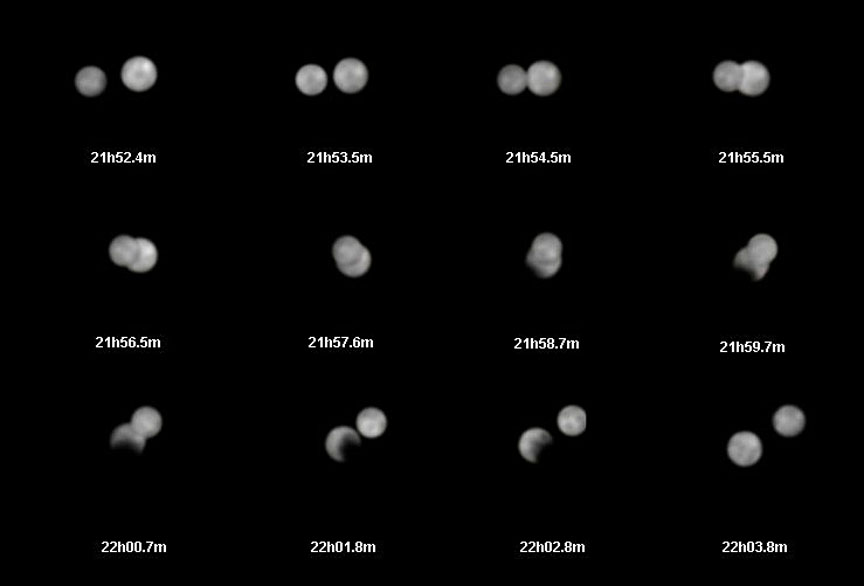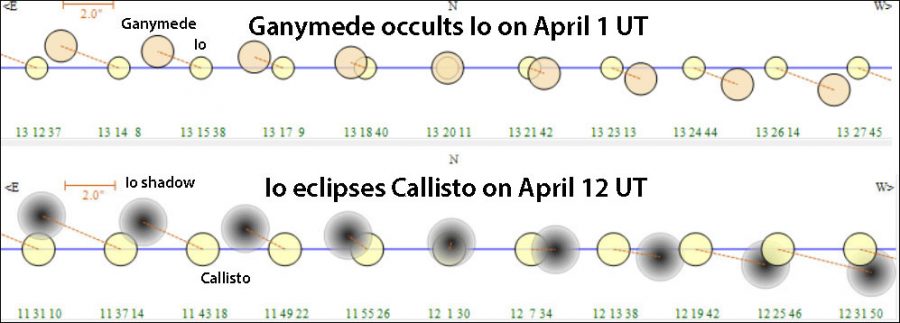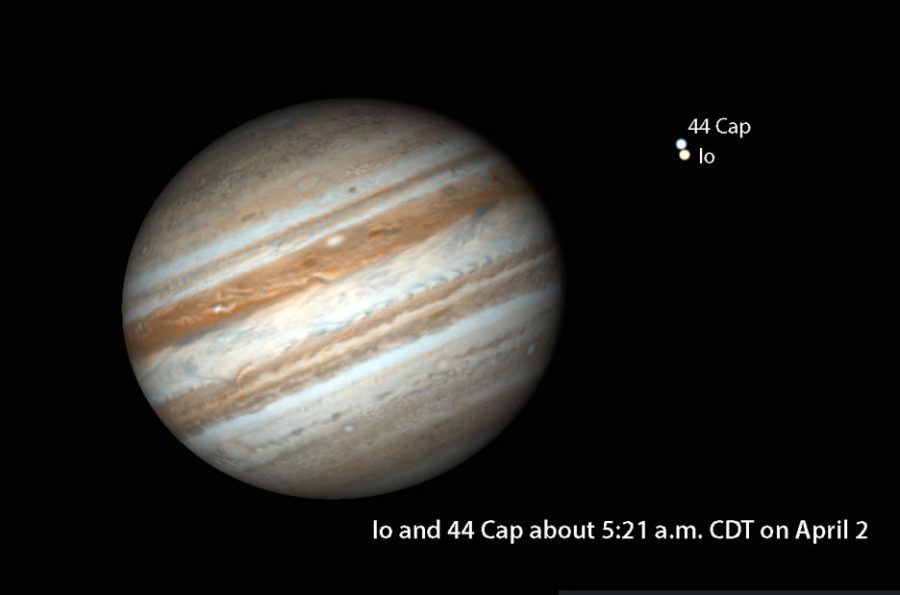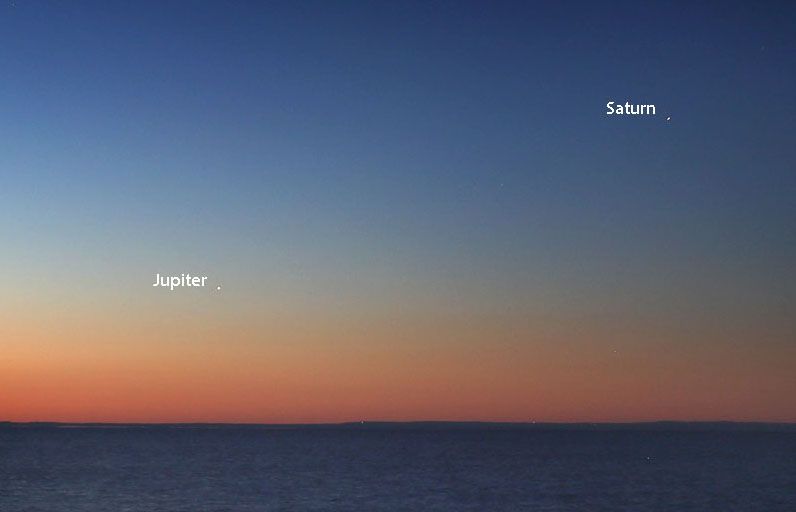Jupiter is usually the one occulting and eclipsing the Galilean moons, but this observing season the moons also eclipse and occult one another.

John Sussenbach
After their spectacular Great Conjunction last December, Jupiter and Saturn overwintered in the solar glare, lost from sight. They've now returned to the morning sky to begin another observing season, and amateurs are eager for a look.
Unlike some planets that hold their details close, Jupiter lets it all hang out. With an apparent diameter nearly double that of Mars at its closest opposition even a modest telescope reveals a colorful cloudscape of shifting belts and zones. The four Galilean moons are constantly on the move, bunching together and spreading apart like ballet dancers in the Nutcracker. If that wasn't enough, you can watch the planet occult and eclipse those satellites or catch a transit, when a moon casts its pinpoint shadow on the gas giant's cloud tops.
The Feeling Is Mutual
But there's something else happening that makes this Jupiter apparition special. Every six years the orbital plane of the four Galilean moons is edge-on with the Sun and Earth, and we enter the season of mutual phenomena, when the moons occult and eclipse one another. The season began on January 3rd when Europa partially eclipsed Io and finishes up on November 16th with a Ganymede-Io occultation. Although Jupiter is still low at dawn it inches higher every morning and will soon be in good view.

In total 242 events occur, of which 192 are observable. An occultation happens when one moon passes in front of another, blocking a portion of the background moon's disk. During an eclipse a foreground moon casts its shadow on a background moon. Both eclipses and occultations can be partial, total or annular.

Sky & Telescope
Depending on the nature of the occultation event, the two moons may appear to barely touch or even completely merge. When closest, the spacing and orientation of the two moons changes rapidly, an exciting sight you can see unfold in near-real time. Magnitude differences between the satellites also make for noticeable brightness changes during an occultation. This is especially true for Jupiter's opposition on August 20th, when the dimmest of the Galilean moons, 5.5-magnitude Callisto fully occults 4.4-magnitude Ganymede, resulting in a dramatic drop in brightness. Similar circumstances occur with Io (magnitude 4.9) and to a lesser extent with Europa (magnitude 5.1).

John Sussenbach
In an eclipse, the dip in brightness varies according to the depth of the eclipse. During a total eclipse a moon may briefly disappear from view in a multi-magnitude plunge. I've included a selective table below, but you can peruse a list of all events at the Institute of Celestial Mechanics and Ephemeris Computing (IMCCE) site.
Table of Portents
| Date | Time (UT) | Event | Mag. (%) |
| April 1 | 13:17 — 13:23 | Ganymede occults Io | 94 |
| April 6 | 11:46 — 11:51 | Europa eclipses Io | 47 |
| April 11 | 10:00 — 10:11 | Io eclipses Callisto | 69 |
| April 12 | 11:50 — 12:12 | Io eclipses Callisto | 80 |
| April 15 | 10:07 — 10:16 | Ganymede eclipses Europa | 95 |
| April 18 | 9:52 — 9:57 | Io eclipses Europa | 87 |
| April 22 | 13:23 — 13:32 | Ganymede eclipses Europa | 81 |
| April 25 | 12:05 — 12:11 | Io eclipses Europa | 98 |
| April 29 | 12:12 — 12:27 | Ganymede eclipses Callisto | 75 |
To use the IMCCE site, click the Show button for the complete list of events. Times for the beginning and end of the event are in Universal Time, so remember to deduct 4 hours for Eastern Daylight; 5 for Central; 6 for Mountain and 7 for Pacific or use this converter. The next column tells you which satellite eclipses (e) or occults (o) another. For example, 1E4 means that satellite I (Io) casts its shadow on satellite IV (Callisto). In 3O2, satellite III (Ganymede) covers II (Europa).

Created with the free WinJUPOS program
The columns that follow give the duration of the event in minutes; the impact factor ( "0" indicates the satellite passes centrally through the shadow or behind the apparent disk of the other satellite, while "1" is a grazing event, and negative values indicate the action occurs in front of or behind Jupiter's disk); M is the combined magnitude of the satellites; Δm is change in magnitude of the two moons before and at the time of the event; limb is the apparent distance of the involved satellite from the planet's limb (in arcseconds); and dist the distance between the two satellites (in arcseconds).
For a wonderful sampling of photos and animations from previous mutual events seasons, be sure to check out the Mutual Events site maintained by avid planetary imager Marc Delcroix.
Mutual phenomena are dynamic events, just the thing to spice up your observing this season. Pull up a telescope and dance the night away with Jupiter's moons.
Playing Hide-and-Seek with 44 Capricorni

Stellarium
A different sort of occultation happens at dawn on April 2nd when the 5.9-magnitude star 44 Capricorni has close encounters of several kinds at Jupiter. As seen from western and central South America, Jupiter will occult the star. Observers in eastern North America will witness the star reappear at the planet's western limb in twilight, at around 6 a.m. EDT. Since Jupiter will be low in the southeastern sky at the time (~12° from 40°N), make sure you find a spot with an unobstructed view.
Observers in the Midwest will miss the occultation but will have front-row seats when Io passes just 0.5″ south of 44 Capricorni around 5:21 a.m. CDT (6:21 EDT for the eastern Midwest). The two equally bright objects will appear to nearly merge and then separate over the span of about 10 minutes. From some locations in Central America and northwestern South America Io will occult 44 Capricorni. For example, in San José, Costa Rica, Io covers the star between 4:18 and 4:20 a.m.
 2
2











Comments
jacobus-nl
April 1, 2021 at 4:49 am
Hi Bob, in the fourth paragraph you mention that “Occultations can be partial or total, while eclipses are partial, total, or annular.” According to the illustration below the paragraph occultations can be annular too!
Anyway, very interesting events to try to observe. Great opportunities to try out my first telescope that should arrive tomorrow! 🙂
You must be logged in to post a comment.
Bob KingPost Author
April 1, 2021 at 2:55 pm
Hi Jacobus,
Of course! Thank you for pointing that out 🙂
You must be logged in to post a comment.
You must be logged in to post a comment.